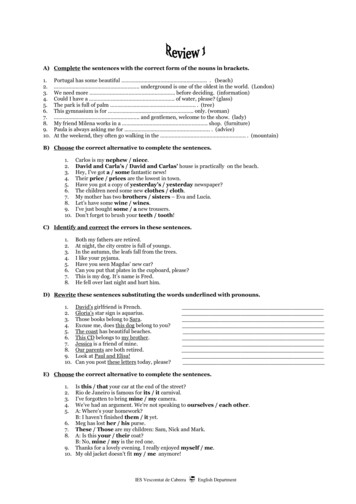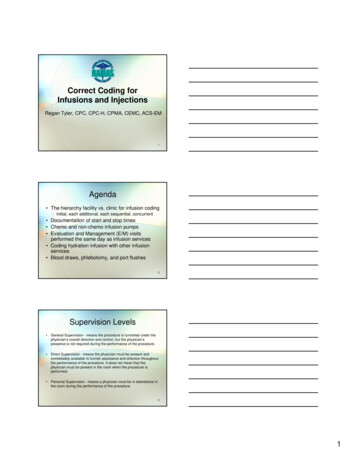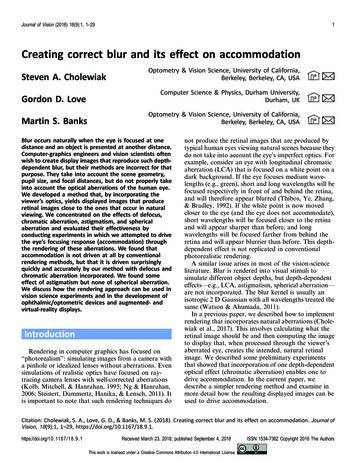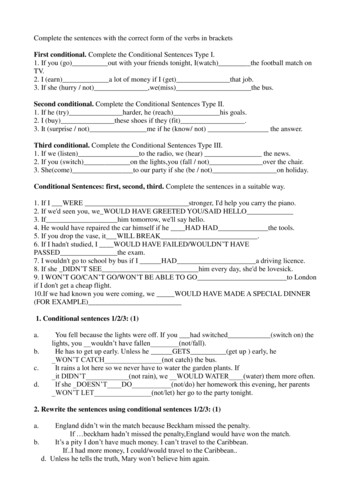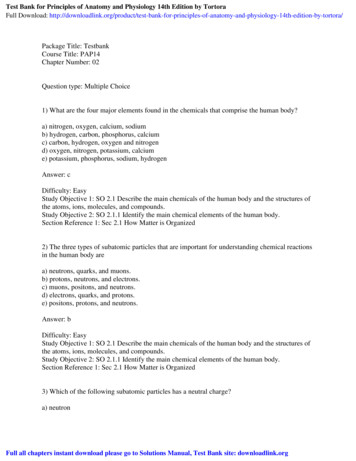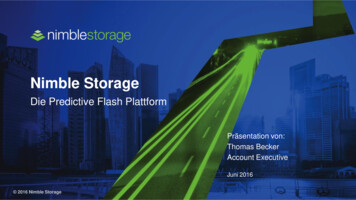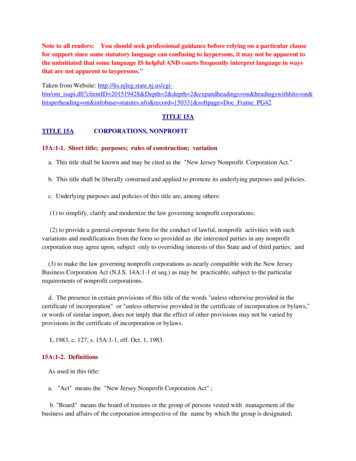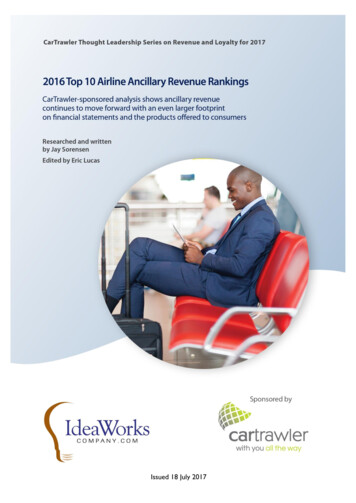
Transcription
Issued 18 July 2017
2016 Top 10 Airline Ancillary Revenue RankingsCarTrawler-sponsored analysis shows ancillary revenue continues to move forward withan even larger footprint on financial statements and the products offered to consumers.ContentsFinancial documents for 138 airlines were reviewed . 5Ancillary revenue as a percent of total revenue favors low cost carriers . 5Global and low cost carriers earn top ancillary revenue per passenger . 8FFPs are a monetary mileage marvel . 9Quo vadis? Or, where is your airline going? . 9Disclaimer: IdeaWorksCompany makes every effort to ensure the quality of theinformation in this report. Before relying on the information, readers should obtain anyappropriate professional advice relevant to their particular circumstances. NeitherIdeaWorksCompany nor CarTrawler guarantee, or assume any legal liability orresponsibility for the accuracy, currency or completeness of the information.The free distribution of this reportis made possible through the sponsorship of CarTrawler.CarTrawler is the world’s leading B2B travel technology platform providing car rental andground transportation options to over 700 million airline passengers annually, through our100 airline partnerships. We connect travellers in real-time, on any device, to everysignificant car rental and ground transportation supplier globally. CarTrawler’s uniquetechnology is an easy to implement platform, personalised based on your customers tripdetails. Our technology provides you with higher conversion rates and increased revenue.For more information visit www.cartrawler.com/bestconversionIssued by IdeaWorksCompany.com LLCShorewood, Wisconsin, USAwww.IdeaWorksCompany.com2016 Top 10 Ancillary Revenue RankingsIdeaWorksCompany.com LLC 2017Page 1
2016 Top 10 Ancillary Revenue RankingsIdeaWorksCompany.com LLC 2017Page 2
About Jay Sorensen, Writer of the ReportJay Sorensen’s research and reports have made him a leading authority on frequent flyerprograms and the ancillary revenue movement. He is a regular keynote speaker at theannual MEGA Event, spoke at IATA Passenger Services Symposiums in Abu Dhabi andSingapore, and has testified to the US Congress on ancillary revenue issues. His publishedworks are relied upon by airline executives throughoutthe world and include first-ever guides on the topics ofancillary revenue and loyalty marketing. He wasacknowledged by his peers when he received the AirlineIndustry Achievement Award at the MEGA Event in 2011.Mr. Sorensen is a veteran management professional with30 years experience in product, partnership, andmarketing development. As president of theIdeaWorksCompany consulting firm, he has enhanced thegeneration of airline revenue, started loyalty programsand co-branded credit cards, developed products in theservice sector, and helped start airlines and other travelJay, with son Aleksei and daughtercompanies.His career includes 13 years at MidwestAnnika, in North Cascades NationalAirlines where he was responsible for marketing, sales,Park in Washington.customer service, product development, operations,planning, financial analysis and budgeting. His favorite activities are hiking, exploring andcamping in US national parks with his family.About Eric Lucas, Editor of the ReportEric Lucas is an international travel, culture and natural historywriter and editor whose work appears in Michelin travel guides,Alaska Airlines Magazine, Westways Magazine and numerous otherpublications. Founding editor of Midwest Airlines Magazine, he isthe author of eight books, including the 2017 Michelin Alaskaguide. Eric has followed and written about the travel industry formore than 25 years. He lives on San Juan Island, Washington,where he grows organic garlic and heirloom corn; visit him onlineat TrailNot4Sissies.com.Eric, at his favorite summer retreat, Steens Mountain, Oregon.Disclosure to Readers of this ReportIdeaWorksCompany makes every effort to ensure the quality of the information in thisreport. Before relying on the information, you should obtain any appropriate professionaladvice relevant to your particular circumstances. IdeaWorksCompany cannot guarantee,and assumes no legal liability or responsibility for, the accuracy, currency or completeness ofthe information. The views expressed in the report are the views of the author, and do notrepresent the official view of CarTrawler.2016 Top 10 Ancillary Revenue RankingsIdeaWorksCompany.com LLC 2017Page 3
2016 Top 10 Ancillary Revenue RankingsThe importance and prevalence of ancillary revenue continues to move forward with aneven larger footprint on airline financial statements and the products offered to consumers.Back in 2007 the top ten airlines, as rated by total ancillary revenue, generated 2.1 billion.Fast forward to financial results of 2016 (shown in Table 1) and the top ten tally has leapt tomore than 28 billion. Yet, the challenges faced by the world’s economy reinforce the needfor airlines to rely upon ancillary revenue as a tool to serve the needs of consumers andinvestors.Table 1: Top 10 Airlines – Total Ancillary Revenue (US dollars)Approximate Sources of RevenueAnnual Results – 2016FrequentA la CarteTravel RetailFlyer Program Such As bags Commissions 6,222,000,000United48%52% 5,172,400,000Delta52%48% 4,901,000,000American43%57% 2,832,800,000Southwest80%20% 2,100,771,801Air France/KLM33%67% 1,982,255,301RyanairNone100% 1,355,078,078 *easyJetNone100% 1,349,812,715 *Lufthansa Network57%43% 1,193,698,000Qantas (excludes Jetstar)90%Limited disclosure 1,179,131,138Air Canada45%55%2016 carrier results were based upon recent 12-month financial period disclosures.* IdeaWorksCompany estimate based upon updated past disclosure and other sources.Total ancillary revenue is presented in a different manner this year to emphasize howairlines produce it. Most top ten airlines earn their place on the table through the robustrevenue contribution of a frequent flyer program. Specifically, these billion-dollar amountsare generated by the sale of miles or points to banks that issue a carrier’s co-branded creditcard. But on this table of giants, Ryanair and easyJet are the exception; their ancillaryrevenue ranking occurs through a reliance on a la carte fees and the commissions earnedfrom travel retail activities at the website, such as car hire bookings and travel insurancesales. The full description of ancillary revenue is offered on the next page.2016 Top 10 Ancillary Revenue RankingsIdeaWorksCompany.com LLC 2017Page 4
Financial documents for 138 airlines were reviewedEvery year since 2007, IdeaWorksCompany searches for disclosures of financial resultswhich qualify as ancillary revenue for airlines all over the globe. Annual reports, investorpresentations, financial press releases, and quotes attributed to senior executives all qualifyas sources in the data collection process. Of the 138 airlines reviewed, 66 were found toreveal financial results related to ancillary revenue. This represents a nearly threefoldincrease from the 23 airlines which disclosed ancillary revenue 11 years ago.IdeaWorksCompany offers a definition of Ancillary RevenueRevenue beyond the sale of tickets that is generated by direct sales to passengers, orindirectly as a part of the travel experience.IdeaWorksCompany further defines ancillary revenue using these categories:1) a la carte features, 2) commission-based products, 3) frequent flyer activities,4) miscellaneous sources such as advertising, and5) the a la carte components associated with a fare or product bundle.From this list, total airline revenue and ridership data were collected to determine the topten airlines in overall ancillary revenue, as a percentage of company revenue, and on a perpassenger basis. The results for the 66 disclosing airlines will be released in September 2017as the annual CarTrawler Yearbook of Ancillary Revenue by IdeaWorksCompany.Ancillary revenue as a percent of total revenue favors low cost carriersIt’s a logical corollary that airlines with low average fares achieve the best “percent of totalrevenue” results. Table 2 is dominated by the leading low cost carriers in the world, andnearly all demonstrate sizeable increases since 2011. Measurement by percentage is areliable indicator because it removes the factor of global currency fluctuations.Table 2: Top 10 Airlines – Ancillary Revenue as a % of Total RevenueAnnual Results – 2016AncillarySourceCompared to their2011 Results46.4%SpiritVarious33.2% 13.2 points42.4%FrontierVarious7.7% 34.7 points40.0%AllegiantVarious27.0% 13.0 points39.4%Wizz AirVarious27.9% 11.5 points26.8%RyanairVarious20.5% 6.3 points26.0%Jet2.comVarious27.1% -1.1 points24.3%VolarisVarious9.5% 15.3 points24.0%Hong Kong Express VariousCarrier began operations in 201322.0%JetstarVarious15.3% 6.7 points22.0%PegasusVarious10.1% 11.9 points2016 and 2011 carrier results were based upon 12-month financial period disclosures.2016 Top 10 Ancillary Revenue RankingsIdeaWorksCompany.com LLC 2017Page 5
Let’s examine the results for Frontier Airlines as a very robust example. Thanks toFrontier’s 2017 filing for an initial public offering of shares, there are new disclosures of thecarrier’s ancillary revenue prowess. The carrier’s systemwide total revenue per passengerwas a modest 114.75 for 2016. That’s the average revenue associated with a passengerand includes about 49 generated by ancillary revenue. A good portion of this amountincludes the optional extras passengers can buy such as checked bags, seat assignments, andsnacks onboard. A small portion of the 49 is also composed of revenue produced byFrontier’s frequent flyer program and commissions from car hire and hotel bookings.The airline was remade as an ultra low-cost carrier (ULCC) during 2014 after IndigoPartners acquired Frontier.1 For 2013 the airline carried 10.8 million passengers2 and for2016 this jumped to 14.9 million on the strength of new ownership, management, and thelow fares made possible by the a la carte method. Numbers reveal the truth – consumersembrace the choices delivered by the branded fare approach. They can click to choosemaximum savings or buy up to add comfort and convenience.Worldwide the a la carte approach long embraced by low cost carriers has been adopted bynetwork airlines. Within the US, American, Delta, and United recently introduced basiceconomy fares (sometimes called seat-only fares) to compete with Frontier and Spirit.These fares reduce the product to a minimalist experience with fees charged for bags andearly seat assignments, no elite upgrades, and a ban on flight changes. Yet when presentedwith higher fare, better service options, the majority of consumers opt to spend more.Recent comments by Scott Kirby, the President of United, reveal 60 to 70 percent ofpassengers buy a higher fare when presented with the Basic Economy option.3 Americandisclosed similar results with 50 percent of customers buying the Main Cabin product whenpresented the opportunity to consider the lower priced Basic Economy branded fare.4Elsewhere in the world, the practice has been adopted by Air France/KLM, British Airways,and Lufthansa as these airlines compete with the likes of Ryanair, easyJet, and Norwegian. Inother regions of the world, basic fares remain a concept to be considered for the nearfuture. That’s the revenue power implicit when consumers are offered a choice to savemoney or spend more . . . most often they spend more.The ancillary revenue pie is unique for every airlineIn the process of collecting data for this report, IdeaWorksCompany makes note whendetails regarding the sources of ancillary revenue are identified. The activity associated witheach of the 66 airlines will be presented in the annual CarTrawler Yearbook of AncillaryRevenue which will be released later this year in September. For some airlines, such asBritish Airways, Delta, and easyJet, the range of disclosure from financial filings andgovernment data provides a rather complete picture of ancillary revenue. Some airlines,such as Hong Kong Express, have chosen to directly disclose their ancillary revenue toIdeaWorksCompany for inclusion in the Yearbook.1Frontier Group Holdings SEC Form S-1 Registration Statement dated 31 March 2017.Frontier Group Holdings SEC Form S-1 Registration Statement dated 31 March 2017.3SkyMoney section of Airline Weekly dated 12 June 2017.4American presentation at Bank of America Merrill Lynch Conference dated 18 May 2017.22016 Top 10 Ancillary Revenue RankingsIdeaWorksCompany.com LLC 2017Page 6
IdeaWorksCompany reviewed the data and made a few adjustments. For example, forBritish Airways, revenue information was found in the annual reports and investorpresentations of IAG, British Airways Holidays, and Avios, and UK government data.“Other activities” were added to equal 0.5% of airline revenue to account for sources suchas car hire and trip insurance commissions. Colors assigned to pie slices vary, however blueshading always designates baggage revenue with red for frequent flyer programs/co-brandedcredit cards.Global Carrier ExamplesBritish Airways2016 Ancillary Revenue SourcesDelta Air Lines2016 Ancillary Revenue SourcesBased upon disclosures and estimatesBased upon disclosures and estimatesOther Activities11%EconomyBranded Fares21%Baggage17%BA HolidaysIncome9%Other Activities4%Assigned Seats13%FFP/CoBranded Card54%Comfort Seating6%FFP/CoBranded Card52%Baggage13%Low Cost Carrier ExampleseasyJet2016 Ancillary Revenue SourcesHong Kong Express2016 Ancillary Revenue SourcesBased upon disclosures and estimatesCredit CardFees5%easyJet PlusMemberships7%Assigned Seats7%Baggage47%Based upon company disclosuresFlexi Fares a laCarteComponent17%Assigned Seats9%Inclusive Fares ala CarteComponent9%Onboard andOther8%Trip InsuranceOther Fees12%Hotel, CarHire, Holidays,FFP1%Baggage68%Onboard Retailand Other10%The large slices of blue demonstrate the importance of fees for checked baggage. The slicesare smaller for global carriers which continue to include a checked bag on their long-haulroutes, such as transatlantic flights. But where Delta and British Airways may have a smallerslice of bag revenue, they certainly generate lots of cash from their frequent flyer programs.The vast majority of activity occurs when airlines sell miles to the banks that issue cobranded cards such as the Delta SkyMiles card issued by American Express.Branded fares, based upon the “good, better, and best” method of retailing, also contributeto ancillary revenue as shown in the Delta and easyJet examples. The entire fare is notcounted as ancillary revenue, but rather the premium above the basic economy fare level ismeasured. Fees assessed for assigned seating are another method for airlines to boost thebottom line. These fees do tread close to the model defined by low cost carriers; adoptionof this practice does pose a risk the perceived quality of global airlines.2016 Top 10 Ancillary Revenue RankingsIdeaWorksCompany.com LLC 2017Page 7
Global and low cost carriers earn top ancillary revenue per passengerThe top performing airlines, when ancillary revenue is expressed on a per passenger basis,are a varied collection (Table 3 below). The definition of ancillary revenue includes theresults produced by a carrier’s frequent flyer program and this can provide a substantialbenefit for global airlines such as Delta, Qantas, and United. For some airlines, thisrepresents billions in revenue as shown in Table 4 (on the following page) and allows theseairlines to remain competitive when ancillary revenue is measured on a per passenger basis.Low cost carriers rely upon a la carte activity by aggressively seeking revenue from checkedbags, assigned seats, and extra leg room seating. Some of the best in this category haveextensive holiday package business with route structures built upon leisure destinations.Allegiant in the US and Jet2.com in the UK share the common bond of emphasizing leisuretravel; these are essentially holiday package companies that own an airline.Table 3: Top 10 Airlines – Ancillary Revenue per PassengerAnnual Results – 2016(in US dollars)**Ancillary2016 and 2011 ComparisonSource (Both years in local currency – no conversion)Spirit 49.89Various19.5%US dollarsAllegiant 48.93Various43.9%US dollarsFrontier 48.60Various434.1%US dollarsUnited 43.46Various19.2%US dollarsJet2.com 42.46Various18.9%GB poundsQantas Airways 42.38Mostly FFP8.2%AUS dollarsVirgin Atlantic * 42.25Mostly FFPAirAsia X 34.41Various 12.2%Malaysian ringgitKorean Air 32.59Various 12.8%Korean wonAlaska Air Group 31.41Various 27.6%US dollars2011 comparison not available2016 and 2011 carrier results were based upon 12-month financial period disclosures.* IdeaWorksCompany estimate based upon past disclosure updated for current report.Significant fluctuations of global currencies suggest using the US dollar as the basis ofcomparison does not effectively convey historical trends. The left side of Table 3 displays2016 ancillary revenue in US dollars, while the right side expresses the 5-year increasewithout currency conversion. For example, the 2011 per person ancillary revenue forAirAsia X is compared to 2016 based upon Malaysian ringgit results. This provides a purecomparison without the influence of a strong or weak dollar during the time period.The results demonstrate the onward march of ancillary revenue on a per passenger basis forthese ancillary revenue giants. Frontier’s eye-popping increase is largely based upon thecarrier’s conversion to the ULCC (Ultra Low Cost Carrier) model described earlier in thisreport. Other factors are at play here too. Airlines are beginning to manage a la carte feesin the same manner as air fares. Lowering some fees might produce more overall revenue ifit encourages more consumers to say “yes” to buy a product. Likewise, prices might beincreased if consumers demonstrate they “gotta have” a particular service at any price.2016 Top 10 Ancillary Revenue RankingsIdeaWorksCompany.com LLC 2017Page 8
This is the classic rule of demand and supply ― the invisible hand of the marketplace definedby the economist Adam Smith. Technology is rapidly being promoted to support what iscalled dynamic pricing; this is the ability to make prices conditional upon a defined set offactors. But caution is warranted here. Just because you can do it . . . doesn’t mean youshould. Consumers, employees, regulators, and investors need to be on board with thesechanges through careful ― not careless ― communication and training.FFPs are a monetary mileage marvelTable 1 at the beginning of this report showed how some carriers truly benefit from therevenue boost of a frequent flyer program with a powerful co-branded portfolio. Table 4adds detail to this presentation by carving out the frequent flyer revenue data from a fewselect airlines.Table 4: Ancillary Revenue Attributed to Frequent Flyer ProgramsProgram NameFFP RevenuePer PassengerUnited MileagePlus 3,022,000,000 21.11Qantas Frequent Flyer 1,088,173,600 21.14Avios – IAG (BA & Iberia) 539,109,946 5.36Azul TudoAzul 218,633,950 10.60Japan Airlines Mileage Bank 198,887,813 4.86Aeroflot Bonus 185,062,151 4.26South African Voyageur 59,446,855 8.592016 results based upon recent 12-month financial period disclosures and IdeaWorksCompany calculations.The co-branding strength of some global regions is apparent with big per passenger resultsposted by airlines in the US, Australia, and Brazil. The power of these programs is readilyapparent when per passenger numbers are evaluated with United and Qantas scoring anaverage of 21 for every passenger carried. Adding a
from travel retail activities at the website, such as car hire bookings and travel insurance sales. The full description of ancillary revenue is offered on the next


![[Page 1 – front cover] [Show cover CLEAN GET- AWAY 978-1 .](/img/13/9781984892973-6648.jpg)
